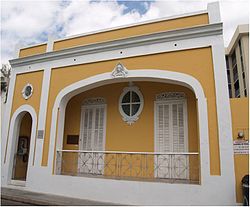| History of Corsica |
|---|
 |
| Part of a series on |
| Puerto Ricans |
|---|
 |
| By region or country |
| Subgroups |
| Culture |
| Religion |
| History |
| Language |
Corsican immigration to Puerto Rico resulted in the 19th century from widespread economic and political changes in Europe that made life difficult for the peasant and agricultural classes in Corsica and other territories. The Second Industrial Revolution drew more people into urban areas for work, widespread crop failure resulted from long periods of drought, and crop diseases, and political discontent rose. In the early nineteenth century, Spain lost most of its possessions in the so-called "New World" as its colonies won independence. It feared rebellion in its last two Caribbean colonies: Puerto Rico and Cuba. The Spanish Crown had issued the Royal Decree of Graces of 1815 (Real Cédula de Gracias) which fostered and encouraged the immigration of European Catholics, even if not of Spanish origin, to its Caribbean colonies.
Contents
- First documented Corsican immigrants
- 19th century Corsica
- Spanish Royal Decree of Graces
- Influence in the coffee industry
- Influence in the sugar industry
- Landmarks in Yauco and Ponce
- Casa Franceschi Antongiorgi
- Casa Antonio Mattei Lluberas
- Chalet Amill
- Mansión Negroni
- Residencia Lluberas Negroni
- Casa Paoli
- Notable Yaucano(a)s of Corsican descent
- Corsican influence in Puerto Rican and popular culture
- Surnames of the first Corsican families in Puerto Rico
- See also
- References
- External links
Hundreds of families emigrated from Corsica to Puerto Rico. Corsicans and those of Corsican descent played an instrumental role in the development of the economy of the island, especially in the coffee industry.








